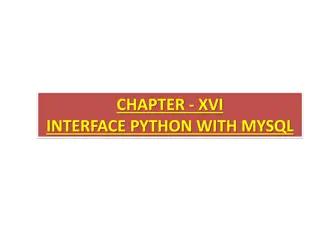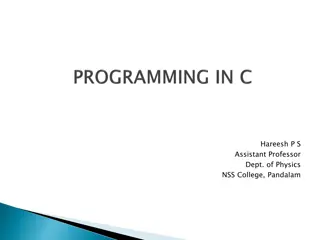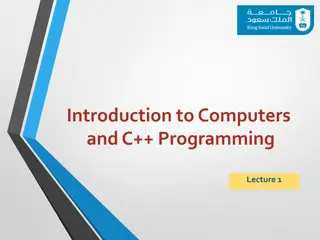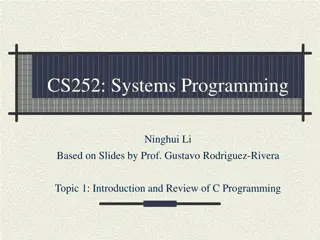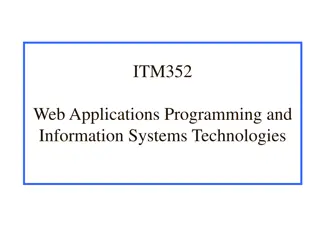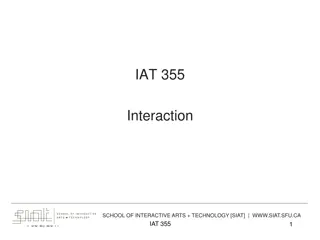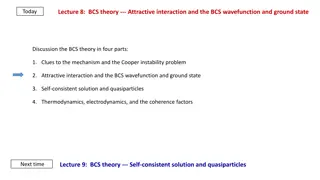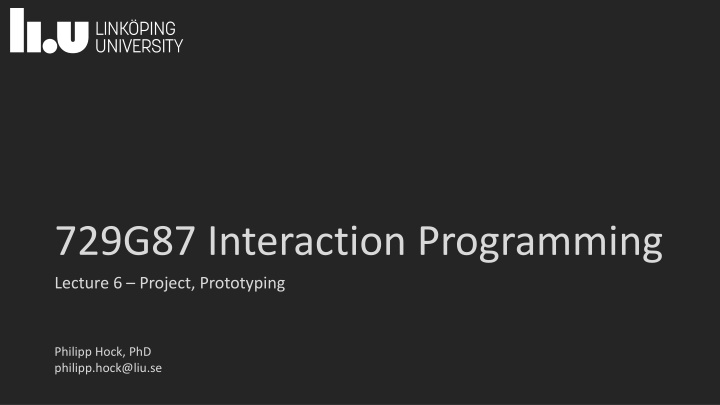
Prototyping Strategies for Interaction Programming Projects
Explore the key aspects of prototyping in interaction programming projects, including feedback evaluation, wireframes, diagrams, and project categorization. Understand the importance of defining project goals, basic features, and deliverables. Learn about complexity levels and the significance of wireframes and specifications in GUI prototyping.
Download Presentation

Please find below an Image/Link to download the presentation.
The content on the website is provided AS IS for your information and personal use only. It may not be sold, licensed, or shared on other websites without obtaining consent from the author. If you encounter any issues during the download, it is possible that the publisher has removed the file from their server.
You are allowed to download the files provided on this website for personal or commercial use, subject to the condition that they are used lawfully. All files are the property of their respective owners.
The content on the website is provided AS IS for your information and personal use only. It may not be sold, licensed, or shared on other websites without obtaining consent from the author.
E N D
Presentation Transcript
729G87 Interaction Programming Lecture 6 Project, Prototyping Philipp Hock, PhD philipp.hock@liu.se
2 Agenda Feedback/Evaluation Assignment 5 Project Wireframes & Diagrams Prototyping Excursion: Game dev Live coding: minigame (if we have time)
3 Last assignment https://729g87.gitlab-pages.liu.se/course_page_astro/assignments/assignment5-inputs_from_hell/ Difficulty Choose a method that suits your skill level Submission No presentation on Friday Create a video of your input method ~30s (max 1min) Should show and explain your input method Can have voiceover and/or subtitles Will be available for all in a single-cut video Your video can be anonymized, does not have to be Provide a link in your gitlab page to The input method(s) The video that demonstrates the input method
4 Recap: Project Same groups as during assignments Choose your project category Web shop Psychological experiment Game Adjust your goals/ideas to your skills Think about basic features that must be in the final project Define some features that should be in the final project What other things could be added in the future? Deliverables Wireframe Specification Gui prototype (drawings of your gui) Behavioral aspects (diagram(s)) Structural aspects (diagram(s)) Implementation Point requirements https://www.ida.liu.se/~729G87/about/examination/
5 Level of complexity Must Haves This is your basic system This is your minimum goal for the assignment Should Haves You aim for this to be in the final prototype Could Haves Realistically speaking, this won't be in the final prototype, but maybe you achieve it. You define this for yourself.
6 Wireframe / Specification Deadline: 22 December Think about your product before you start coding GUI prototype Wireframe No program logic Should visualize the final product Can be more than you implement Structural diagrams Model the structure of your system Does not have to model the entire system Behavioral diagrams Model behavioral aspects of your system Does not have to model all interactions Do not build your final system with the prototyping software
7 Web shop Browse items and interact with shopping cart Functional requirements: browse items items have more then one picture items have a description add/remove/edit items in shopping cart view shopping cart Example subcategories: clothing store, food store .. Do not clone an existing shop
8 Psychological experiment Get inspired by https://www.psytoolkit.org/experiment-library/ Classical experiments are Stroop task N-back task Go/No-go task Such experiments are intended to create certain stimuli Increase cognitive load Induce stress Increase memory workload In each experiment, performance is measured and later analyzed Experiment must include a performance evaluation (statistics of how participants performed on the task) Difficulty to implement differ Get feedback from teaching assistant/me before starting
9 Game Games can be very simple but can become very complex to implement! Initial feedback from teaching assistant/me is mandatory! Some games require server-side logic. You have no access to custom server-side logic Do not implment such games Probably the most complex choice Rewarded by lots of fun implementing and playing Classic games are Pong Snake Blackjack Breakout Tetris (can be very challenging) You can also create your own game Add a custom feature that is not in the original game https://developer.mozilla.org/en-US/docs/Games/Tutorials/2D_Breakout_game_pure_JavaScript
10 Libraries & Frameworks Web development usually heavily relies on libraries, frameworks, etc You learned mostly vanilla web development here You are free to use frameworks Mind they can have different learning curves Only tools/frameworks are allowed that allow development in js/ts No game engines (Unity, Unreal, Godot, ) Js game engine libraries are ok! We might not be familiar with the framework you use Don t expect help There are many many js frameworks https://blog.logrocket.com/best-javascript-html5-game-engines/ https://github.com/KilledByAPixel/LittleJS
11 Presentation Deadline: 12 January Present your project Live demo Have a backup video if live demo fails (video) Prepare some slides with insides of the development process Focus on showing the final project not code 180min timeslot, 29 groups 5min presentations Stay in time!
12 Requirements for game and psy. Exp. Should not copy an existing implementation entirely Add your own ideas! Modify the basic concept of the original system Come up with an entirely new idea Be bold Set your goals high, it's ok if you don't achieve them Better not to meet high targets than to meet low targets too early Be creative!
13 Games Too simple* Tic Tac Toe Guess the number Appropriate complexity** Memory Snake Sudoku Minesweeper Breakout Tower defense Platformer Too complex** Multiplayer (nearly impossible without a custom server) Real time strategy game SimCity Online Poker * You can add more complexity to a simple game ** Varies in complexity *** You can remove features from a complex game
14 Psychological experiment A lot of experiments are simple Add your own ideas to change/improve the experiment Make it customizable Add features Combine experiments Stroop-Task add additional difficulty levels Countdown timer Change input modality Do not forget to integrate the evaluation of user performance
15 Vertical & Horizontal prototype Nielsen, J. (1993). Usability Engineering. Morgan Kaufmann Publishers In. Inc. 1993
16 https://www.nngroup.com/articles/wireflows/ Wireframe & Wireflow diagrams Wireframe diagram Visualizes the product Horizontal prototype
17 https://www.nngroup.com/articles/wireflows/ Wireframe & Wireflow diagrams Wireflow diagram Visualizes the Product experience From the user s perspective Interaction flow Horizontal prototype
18 Wireframe tools Penpot - https://penpot.app/ Adobe XD - https://www.adobe.com/se/products/xd.html)- Axure - installed on Windows computers at IDA Figma https://www.figma.com/ MockFlow - https://www.mockflow.com/ NinjaMock - https://ninjamock.com/ Pencil - http://pencil.evolus.vn/ Wireframe.cc - https://wireframe.cc/
19 UML Diagrams Unified modelling language Various different types of diagrams Flow Charts Class Diagram Sequence Diagram Communication Diagram Pre-development phase Document a process Present solution to a problem Brainstorm ideas in a meeting Design an operation system Useful in bigger development teams
20 UML Diagrams Structural diagrams E.g., class diagram, component diagram Behavioral diagrams E.g., Activity diagram, flow-charts, state-charts Interaction diagrams E.g., component diagram, sequence diagram From the programmer s perspective Models program logic
21 Diagram tools https://app.diagrams.net/ https://inkscape.org/ https://wireflow.co/ https://www.yworks.com/products/yed MS Visio
22 Class diagrams (example) [Structural] https://commons.wikimedia.org/wiki/File:LOM_base_schema.png
23 Class diagrams Structure Visualization: Depicts the static structure of a system. Classes: Represents classes, which are blueprint templates for objects. Focus on object-oriented programming Attributes: Displays class attributes (variables) that store data. Methods: Shows class methods (functions) that define behavior. Relationships: Illustrates associations, inheritance, and dependencies between classes. System Overview: Provides an overview of data organization and system components.
24 Flow chart [behavioral] Khan, M. M., Shams-E-Mofiz, M., & Sharmin, Z. A. (2020). Development of E-commerce-based online web application for COVID-19 pandemic. IBusiness, 12(4), 113-126.
25 https://www.nngroup.com/articles/wireflows/
26 Activity diagrams [Behavioral] Workflow Representation: Visualizes workflows and processes. Actions Depicts actions or tasks within the workflow. Decisions Includes decision points and branching paths. Concurrent Activities Shows parallel and synchronized actions. Transitions Illustrates transitions between activities. Clear Sequence Highlights step-by-step execution order. https://en.wikipedia.org/wiki/Activity_diagram#/media/File:Activity_conducting.svg
27 Activity diagrams [Behavioral] stadia (white boxes) = actions diamonds represent decisions bars represent the start (split) or end (join) of concurrent activities; a black circle represents the start (initial node) of the workflow an encircled black circle represents the end (final node). https://en.wikipedia.org/wiki/Activity_diagram#/media/File:Activity_conducting.svg
28 Components https://www.zenflowchart.com/flowchart
29 State chart example [Behavioral] Event / action
31 Simple movement let p_static_y = 0; const player_static = document.querySelectorAll("div")[1]; function animateStatic() { p_static_y += 1; player_static.style.left = p_static_y + "px"; player_static.innerText = parseInt(p_static_y); requestAnimationFrame(animateStatic) } animateStatic() Problem: Movement speed dependent on framerate! https://gitlab.liu.se/729g87/HT2023/ball/ https://ball-729g87-ht2023-a971129c087b15485fd5e41531289e03b2a8d2be7d77.gitlab-pages.liu.se/movement.html
32 Animate using setTimeout let p_static_y = 0; const player_static = document.querySelectorAll("div")[1]; function animateStatic() { p_static_y += 1; player_static.style.left = p_static_y + "px"; player_static.innerText = parseInt(p_static_y); setTimeout(()=>{animateStatic()}, 1000) } animateStatic() Problem: Movement speed dependent on framerate!
33 Simple movement let py = 0; const player = document.querySelectorAll("div")[0]; const playerSpeed = 60; let lastT = 0; function animate() { let time = performance.now() / 1000; let dt = time - lastT; py += playerSpeed * dt; player.style.left = py + "px"; player.innerText = parseInt(py); lastT = time; requestAnimationFrame(animate); } animate();
34 Game Engine Attributes: - Position - Velocity - Dimensions - Elements
35 Game Engine - Position - Velocity - Dimensions - Position - Velocity - Dimensions - Position - Velocity - Dimensions Elements
36 Game Engine Wall-Model - Position - Velocity - Dimensions Enemy-Model Player-Model - Position - Velocity - Dimensions - Position - Velocity - Dimensions Elements
37 Game Engine - Position - Velocity - Dimensions - Position - Velocity - Dimensions - Position - Velocity - Dimensions Controller Elements
38 Game loop - read input - update values - draw scene - repeat
39 Game loop - read input - update values - draw scene (user -> controller) (controller -> model) (model -> renderer) - repeat (loop/recursion) The user performs an input (e.g., arrow key is pressed) The controller registers this and updates the model accordingly (e.g., change position) The renderer draws the scene based on the model data (draw ball)
40 https://ball-729g87-ht2023-a971129c087b15485fd5e41531289e03b2a8d2be7d77.gitlab-pages.liu.se/ https://gitlab.liu.se/729g87/HT2023/ball/
41 Architecture game.js Controller Handles player input Ball.js Holds the data to render the ball Has position, velocity, radius Has methods to manipulate velocity Engine.js Combines rendering and game loop Renders the ball Execures gameloop



